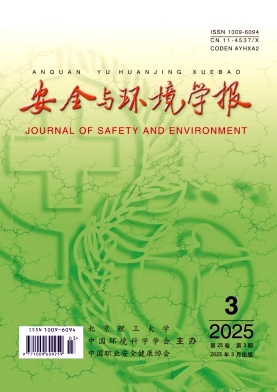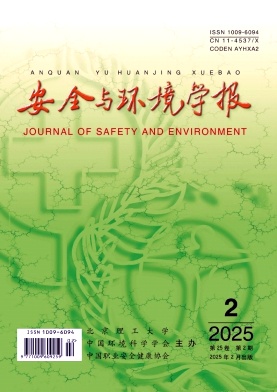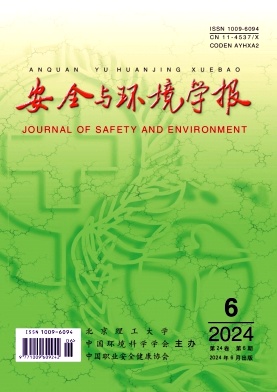Tracking the information about your manuscript
Communicate with the editorial office
Query manuscript payment status Reviewer LoginOnline Review
Online Communication with the Editorial Department Author LoginCollecting, editing, reviewing and other affairs offices
Managing manuscripts
Managing author information and external review Expert Information
Downloads
Page Views
Page views today:13
About the Journal
 Superintended by:China North Industries Group Corporation Limited
Superintended by:China North Industries Group Corporation Limited
Sponsoredy:Beijing Institute of Technology, Chinese Scoiety for Environmental Sciences, China Occupational Safety and Health Association
Edited & Published by: Editorial Department of Journal of Safety and Environment
Issues per year: 12
ISSN 1009-6094
CN 11-4537/X
Research on key causes identification and prediction of ground proximity warnings during the approach phase at plateau airports
QI Yannan;ZHAO Jiaxing;WU Zuoyu;ZHAO Yu;To ensure the safe operation of aircraft during the final descent phase, this paper investigates the key causes and predictive factors associated with Ground Proximity Warnings at plateau airports. First, parameters are extracted from four aspects—environment, aircraft state, aircraft control, and trajectory—to establish a preliminary set of causal factors. The similarity characteristics among these parameters are assessed by calculating mutual information values, which allows for the elimination of redundant parameters. Additionally, the FP-Growth association rule analysis algorithm is employed to identify key causes. Finally, to tackle the high dimensionality of flight sample data and the black box nature of machine learning prediction processes, a fusion of Convolutional Neural Networks(CNN) and decision tree algorithms is utilized to develop a ground proximity warning prediction model. The key causes that trigger ground proximity warnings, along with the prediction model, were validated using Quick Access Record(QAR) data from Aspen Airport, a plateau airport in the United States. The research identified six association rules related to ground proximity warnings: FATA-1 and VRTG-1—Pattern 1; W_h-1 and IVV-1—Pattern 1; FATA-1 and SPLG-1—Pattern 2A; VRTG-1 and SPLG-1—Pattern 2B; IVV-1 and CW-1—Pattern 4; and W_h-1 and ELEV-0—Pattern 5. All of these rules represent key causes involving combinations of multiple indicators. The prediction algorithm was validated using flight data that had been subject to data augmentation. The prediction results demonstrate that the combined model can effectively predict ground proximity warnings based on the operational parameters during the initial descent phase, achieving an average accuracy of 86.1%. The analysis and verification of randomly selected samples predicted for each mode revealed that the positive samples identified by the model indeed corresponded to instances where Ground Proximity Warnings were triggered in actual flights. In comparison to other prediction models, the model presented in this paper demonstrates superior performance in terms of accuracy, recall, F1 score, False Alarm Rate(FAR), and Critical Success Index(CSI), further validating its reliability and effectiveness.
[Downloads: 189 ] [Citations: 0 ] [Reads: 2 ] PDF Cite this article
Identification of critical risk factors and their interaction mechanisms in aircraft apron operational safety
LI Mingjie;YIN Tiance;FENG Sirong;This study aims to improve the safety of apron operations by identifying and analyzing critical risk factors. To accomplish this, we compared several existing methods for risk factor identification and ultimately chose grounded theory due to its effectiveness in extracting meaningful insights from qualitative data. Using this method, we analyzed incidents from 56 transportation airports and selected 17 representative cases for in-depth study. From these cases, we identified 11 key risk factors that pose a threat to apron safety. These factors encompass human behavior, equipment conditions, management practices, and environmental influences. We subsequently developed an enhanced Decision-Making Trial and Evaluation Laboratory(DEMATEL) model that integrates Interval Type-2 Fuzzy Sets(IT2FS) with the Ordered Weighted Averaging(OWA) operator. This model effectively addresses uncertainties in expert evaluations by capturing hesitant and fuzzy judgments more accurately. Expert opinions were initially assessed using the original DEMATEL method and subsequently reanalyzed with the improved model. The results indicate that the enhanced model more accurately reflects real-world complexities and aligns closely with expert intentions, thereby enhancing the accuracy and reliability of the findings. Our analysis identifies four critical factors: S1(personnel quality), S11(supervision), S2(operational behavior), and S9(training management). These factors received the highest centrality scores, measuring 10.34, 9.96, 9.94, and 9.90, respectively. These results underscore the pivotal roles these factors play in ensuring apron safety. Prioritizing them can significantly reduce risks associated with apron operations. This study illustrates the advantages of incorporating advanced fuzzy techniques into risk analysis models, as the enhanced DEMATEL model improves the robustness and applicability of expert evaluations. Furthermore, identifying high-centrality factors lays a solid foundation for developing training protocols, revising supervision standards, and enhancing operational practices specifically tailored to the apron environment. Overall, our findings offer actionable insights for creating targeted safety strategies in aviation apron operations. This framework serves as a practical tool for enhancing both safety and operational efficiency within the aviation industry.
[Downloads: 16 ] [Citations: 0 ] [Reads: 0 ] PDF Cite this article
Dynamic coupling analysis of risk factors in ship self-sinking accidents using the N-K-DBN model
CUI Xiufang;ZENG Jiexi;SHAO Zhipeng;AN Nannan;Maritime accidents in China occur frequently, and when multiple factors are dynamically coupled, the risk of exceeding threshold values increases, potentially leading to accidents that result in casualties, economic losses, and environmental hazards. Therefore, this study quantitatively analyzes the dynamic coupling relationship governing the evolution of ship self-sinking risks and identifies the key factors contributing to these accidents. This paper first introduces the N-K model and dynamic Bayesian networks to investigate the dynamic coupling characteristics of ship self-sinking accident risks. Using 146 self-sinking accident cases published by the Maritime Safety Administration, the risk factors are classified, and their coupling mechanisms are explored. Next, the N-K model is constructed to quantify the coupling values and analyze their relationships. The secondary factors are utilized as parent nodes to construct a Bayesian Network(BN) correlation network represented by a directed acyclic graph. The coupling value is incorporated into the BN network to optimize its probabilities and minimize subjectivity. Finally, a dynamic coupling model of Dynamic Bayesian Network(DBN) risk is established by incorporating time slices into the Bayesian Network framework. This model facilitates risk probability analysis, sensitivity analysis, forward reasoning, reverse diagnosis, and uncertainty analysis to identify key and catalytic factors influencing dynamic risk correlations. The goal is to achieve dynamic control of coupling risks in navigation, leading to the development of risk management strategies and preventive measures aimed at enhancing maritime safety. The results indicate a positive correlation between ship sinking accidents and the dynamic coupling value of risks, meaning that as the coupling factors increase, the risk level also rises, reflecting a stronger interaction among these factors. In the early stages of an accident, subjective behavioral elements such as human and management factors are identified as key contributors to ship sinking incidents, with their cross-coupling resulting in a heightened level of risk. As time progresses, the influence of objective factors, such as ship-specific characteristics, on accidents gradually increases. These factors are more likely to cross-couple with human factors, leading to heightened dynamic risks. Adverse weather conditions serve as a catalyst that facilitates the coupling of ships with other factors, increasing the likelihood of multi-factor cross-coupling risks and consequently raising the probability of accidents. The study identified several key dynamic risk coupling factors that contribute to self-sinking accidents, including weak safety awareness, inadequate company management, ship failure, unseaworthiness, improper ship management, and company failures. Additionally, severe weather conditions were recognized as a significant catalytic factor in these dynamic risk couplings.
Application of an improved N-K model for coupling analysis of construction safety risks in prefabricated buildings
YANG Wenan;XU Biqin;YAN Yuxin;To identify the key safety risk factors in prefabricated construction and explore the coupling mechanism between these factors, an improved N-K model is developed for coupling analysis. First, based on on-site interviews, expert consultations, policy organization, and literature analysis, a safety risk indicator system is established using grounded theory. This system addresses five key aspects: personnel, technology, management, equipment, and environment. Secondly, the Decision-Making Trial and Evaluation Laboratory(DEMATEL) method and the entropy weight method are used to calculate both subjective and objective weights. Game theory is then introduced to compute the comprehensive weights of indicators through combination weighting. Based on the centrality ranking derived from the DEMATEL method, the key safety risk factors in the secondary indicators are identified. Next, based on the risk coupling mechanism, an improved N-K model is constructed. In this model, the probability values typically derived from statistical accident cases in traditional coupling models are replaced with the comprehensive weights of secondary indicators. The model then calculates the risk coupling information interaction values between each primary indicator. Finally, engineering examples are used to demonstrate the applicability and reliability of the improved N-K model in the coupling analysis of safety risk factors in prefabricated construction. The results show that key safety risk factors include personnel safety awareness, on-site construction safety management levels, and non-standard behaviors of personnel. The coupling T-value of risks associated with personnel and management factors is relatively high, indicating that these factors significantly impact the coupling of various risk elements. Furthermore, an increase in the number of risk coupling factors correlates with a higher value of risk coupling interaction information, which increases the likelihood of safety accidents occurring. Relevant measures should be implemented to focus on controlling key safety risk factors and to prevent the coupling of multiple risk factors. The findings of this research offer valuable insights for further analyzing the coupling mechanism of safety risk factors in prefabricated construction.
[Downloads: 453 ] [Citations: 0 ] [Reads: 1 ] PDF Cite this article
Application of an enhanced entropy weight method combined with the grey cloud model for safety evaluation of bridge crane hoisting mechanisms
WANG Quanwei;XU Kun;CHEN Zewei;LIU Yilin;WEN Hao;To tackle the challenges posed by uncertain indicator information and complex grade attribution in the safety assessment of bridge crane hoisting mechanisms, this study proposes a novel safety evaluation methodology that integrates combined weighting with grey cloud modeling. Beginning with an analysis of the structural composition and accident causation related to bridge crane hoisting mechanisms, this paper systematically identifies potential safety risk factors and establishes a comprehensive safety evaluation index system based on pertinent safety and technical standards. For weight assignment, the Fuzzy Analytic Hierarchy Process(FAHP) and an improved entropy method are utilized to calculate subjective and objective weights, respectively. A game theory-based combination method is then applied to integrate these dual weights, effectively balancing the advantages of both approaches. In terms of evaluation methodology, we introduce an innovative grey-cloud model that synergizes grey theory with cloud models, thereby overcoming the limitations of each individual method in addressing fuzziness and randomness. A systematic safety evaluation procedure based on the grey-cloud model is subsequently proposed. Using a specific bridge crane hoisting mechanism as a case study, we first conduct quantitative processing of the evaluation indicators. The combined weighting method calculates comprehensive indicator weights, which are then used in the grey-cloud model computation to assess safety levels for both individual components and the entire system. The comprehensive grey-cloud clustering coefficients for the hoisting mechanism are(0, 0, 0.2770, 0.4943, 0.2356). According to the maximum membership principle, the coefficient “0.494 3” corresponds to the “mildly hazardous” classification. A comparative analysis with the fuzzy comprehensive evaluation method shows consistent conclusions at the system level, both indicating a “mildly hazardous” status. However, the proposed method exhibits superior accuracy in assessing individual components. Case verification and model comparison confirm that this methodology objectively and accurately reflects the actual safety conditions of hoisting mechanisms and their components. It provides a viable technical approach for the safety evaluation of bridge crane hoisting mechanisms. The integrated approach effectively addresses information uncertainty and grading complexity present in traditional evaluation processes, offering valuable theoretical guidance and methodological references for equipment safety management.
[Downloads: 705 ] [Citations: 0 ] [Reads: 1 ] PDF Cite this article












































































































































































































